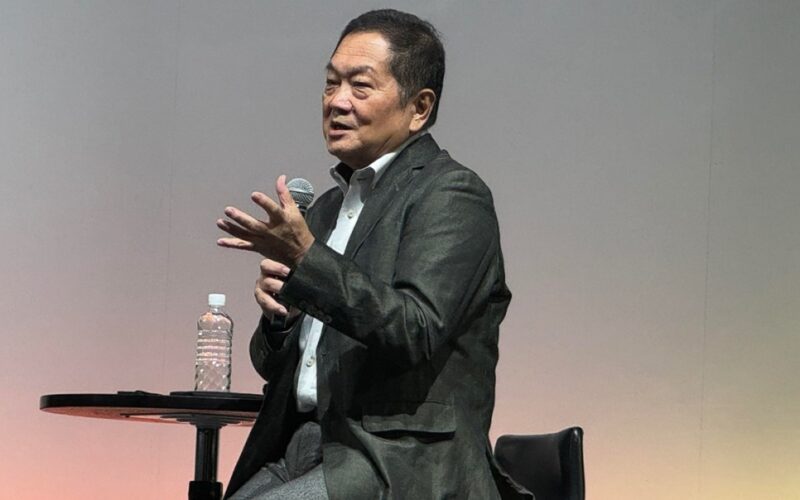Ken Kutaragi, father of the PlayStation, gave an opening keynote at the Tokyo Game Show where he said the game industry could grow by more than 10 times to 100 times as it kicks off the age of real-time computing.
Kutaragi did a fireside chat with Katsuhiko Hayashi of Kadokawa Game Linkage. Kutaragi said his dream is to see games continue on a progression that he has been talking about for decades. He spoke in Japanese and his words were translated on YouTube.
Back before he was leading games at Sony and launching the original PlayStation (in 1995) and the PlayStation 2 (in 2000), Kutaragi spoke of the era of computer entertainment. He saw that games had started in the world of toys and graduated to video games. With the computing power of the PS2, he believed that game consoles and their volume production would start to beat on the PC.
This never really came to pass, but he predicted that games would enter an age of computer entertainment. With AI and other new technologies, he now expects games to graduate to an era of real-time computing.
Join us for GamesBeat Next!
GamesBeat Next is almost here! GB Next is the premier event for product leaders and leadership in the gaming industry. Coming up October 28th and 29th, join fellow leaders and amazing speakers like Matthew Bromberg (CEO Unity), Amy Hennig (Co-President of New Media Skydance Games), Laura Naviaux Sturr (GM Operations Amazon Games), Amir Satvat (Business Development Director Tencent), and so many others. See the full speaker list and register here.
Now 74 years old, Kutaragi is now affiliated with Ascent, a Tokyo-based AI and robotics company developing software designed to go beyond the capabilities of conventional robots. He is also a professor of informatics at Kindai University.
Kutaragi said he fondly recalled the launch of PlayStation in December 1994 in Japan and 1995 elsewhere. Burned by Nintendo as it chose to use Phillips as its game console CD-ROM vendor instead of Sony, Sony execs were angry and wanted to break into the game business on their own. Before the PS launch, Kutaragi pitched game developers, but they weren’t interested in supporting a Sony console, Kutaragi said.
“You are going to fail, they said. Nobody believed we would be successful. Even in Sony,” he said.
In spring of 1993, there were rivals like 3DO, Sega and Nintendo. They were all very different platforms, and each of them had great games. Sony began making more of its own games, on the bet that game technology would evolve over decades into something much bigger. But Kutaragi was happy that Sony had a unique vision.
Before PlayStation, he said, games were like toys, he said. And arcade machines were made in the tens of thousands, but that wasn’t enough to create volume production advantages for chips and other components. Sony’s approach was to take this industry and move it squarely into video games. But Kutaragi had a vision for something bigger, where consoles could lead to computer entertainment.
One of the amazing things he talked about years earlier was the ability to cost reduce the game consoles on a rapid pace. Every year or two, semiconductor tech took a leap forward thanks to electronics innovation on the pace of Moore’s Law, which predicted the number of components on a chip would double every couple of years. Back then, the law stayed on its pace. And Sony was able to take the costs of the original Emotion Engine CPU for the PlayStation 2 to around 13% of its original cost. And that led to regular price cuts that put the game console in the reach of the masses. Understanding these economics enabled Sony to dominate the market in the face of competition from Nintendo and Xbox.
“We have AI today. But who would have foreseen it one year ago? Ten years ago? We had a vision,” he said.
Like Silicon Graphics, Kutaragi had the ambition to make games interactive in real time. CD-ROMs were on the slow side and eventually games became more and more responsive to the player’s desire for interaction.
Kutaragi is certainly building some hype for the AI age. He is entitled some respect as a visionary as the father of the PlayStation. His vision ran into a buzzsaw of reality when he tried to sell the PlayStation 3 for $600. He ended up leaving Sony after that, and Mark Cerny became the architect of the x86-based PlayStation 4 and PlayStation 5.

Kutaragi believes that the push to real-time computing is where technology will go. In the early days, Sony worked with those who came around to believe in the revolution. Namco was one of those and they cooperated to advance the state of game computing. When games came to love game titles for the PlayStation like Ridge Racer, Kutaragi felt like games had become the new rock concerts. Gamers stood in light to get their hands on the consoles at launch.
“That really moved us,” he said. “That was proof of what we had done” and what they had dreamed about.
Kutaragi showed a bunch of the early PlayStation commercials that got people to understand the power of the console. Asked about the AI revolution, Kutaragi said the age of real-time computing would succeed the age of computer entertainment.
“Entertainment changes over time,” he said. He showed a slide of 2001: A Space Odyssey and the tech dreamed up as sci-fi for the 1968 film. Kutaragi sees the day of combining the trends into a single wave of new technology.
“It’s coming,” he said. “It’s not only about gaming. It’s still in the fantasy world today. But a lot of industries can be integrated.” Kutaragi thinks the game industry of 28 trillion yen can be grown ten times or 100 times.
Source link lol

